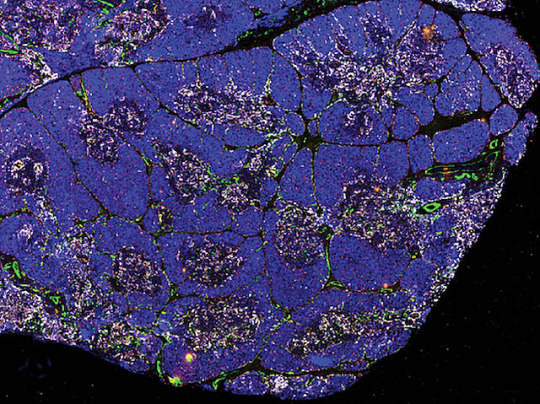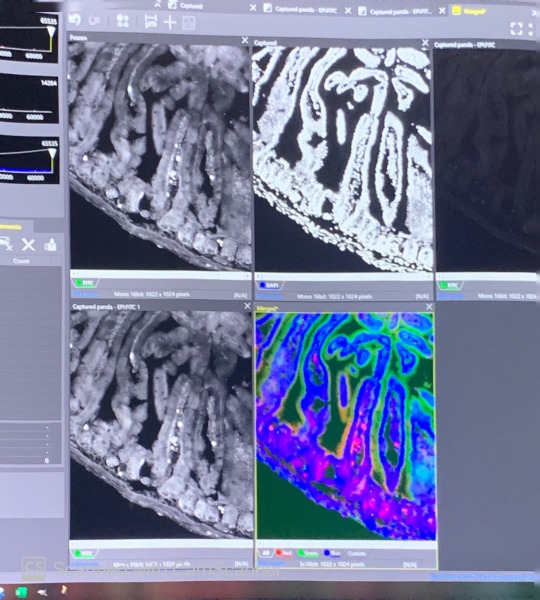#epithelial cell
Explore tagged Tumblr posts
Text
if they really wanted me to stop pulling dry lip skin off before it heals they wouldn't make it the most satisfying thing in the world
7 notes
·
View notes
Text
dude i have to wake up in 6 hours and im really tired but i have homework due in 9 hours that i know i will not wake up early enough to do so i have to do it right now
#pain of a college student#man i did not miss these sleepless nights#staring at the layers of epithelial cells and forgetting the difference between stratified and basal again#this bird speaks#this bird studies
12 notes
·
View notes
Text
Mechanics of Dividing
Quantitative analysis of hundreds of epithelial cell divisions reveals the stresses and forces experienced at a particular phase of the cell cycle influence the orientation of cell division in the developing fruit fly embryo
Read the published research article here
Video from work by Guy B. Blanchard and Elena Scarpa, and colleagues
Department of Physiology, Development and Neuroscience, University of Cambridge, Downing Street, Cambridge, UK
Video originally published with a Creative Commons Attribution 4.0 International (CC BY 4.0)
Published in Development, May 2024
You can also follow BPoD on Instagram, Twitter and Facebook
#science#biomedicine#biology#cell division#developmental biology#epithelial cells#cell cycle#drosophila
13 notes
·
View notes
Text
scheduling a pee break in the middle of microscopy class to check the donmar announcement
#lie i will be totally engrossed in epithelial cells of the stomach and forget probably :(#macbeth#donmar warehouse
4 notes
·
View notes
Text
Do you think fate would be a creature, kind of like God? Something unknowable to us but also we are unknowable to them. We can pretend to understand as they may do us. Too macroscopic for us to see and study all of them at once. Us too microscopic for them to see and study us either. You know homeostasis, how things aim to be dynamically unchanged? Our pH, temperature, so many things where we are just a tiny sliver, a tiny line, a thin border, like our own skin. We can only live in our skin, and isn't it terrifying to realize how thin that is? Doesn't it make sense we can be dynamically unchanged? Going through the same cycle because some part of us fears a death that will happen? Afraid we will not be? But some things can be a positive feedback loop, for better or worse. Building muscle is a positive feedback loop, in my mind. Pregnancy. Death too, in a sense. It is not always some that will be good for you, but something can change. I am not the same person I was last year. That person is dead. Yet, do I fear that death? I don't know. So what if fate was like that? Afraid that things skewing off of fate's path would bring its end not knowing that just a different version of them will leave? What if things skewing was uncomfortable for it, like an itch, a hiccup, and so they go to stop it, not Willing to grow or evolve. But what if, what if it did? For a second? For a day? What if fate gets tired and for once, for once, it can rest and see what happens. For once, it knows it can't know everything. Wouldn't that be nice?
#my post#I just think it's fun to think about#kind of like to all the microbiomes and somatic cells and everything else we are composed of#most of the time they are at our mercy. we are the gods to them. neither of us can fully understand each other#that epithelial cell will never understand my existence and I will never understand theirs#but isn’t it nice to try?#isn’t that part of what science is about?#to me it is#i hope I get the chance to finish my degree one day#i miss it#i should learn about apoptosis again#does the cell fear its death or accept it#does it views its death as the greater good?
0 notes
Text
0 notes
Text
0 notes
Text
I can't fucking believe my mom genuinely thinks she has parasites inside of her jesus fucking christ, goes to the goddamn vitamin shop, "oh they laugh at you bc you have a conventional doctor" says the snakeoil seller, these fucking wormwood/black walnut pills are just gonna make you shit that's the fucking natural process
#I TOOK PARASITOLOGY#DMG TO STOMACH EPITHELIAL CELL WILL SIGNAL ALARMINS#make cd4 into th2 cells that dump IL4 (and IL13)#weep and sweep process more water and contractions as a result aka shitting#.txt
0 notes
Text
youtube
#MAD2L1#colorectal cancer#CRC progression#Wnt/β-Catenin pathway#chemoresistance#oxaliplatin resistance#tumor invasion#cancer cell migration#epithelial-mesenchymal transition#EMT#cell cycle regulation#cancer signaling#metastasis#therapeutic targets#cancer biomarkers#drug resistance mechanisms#precision oncology#tumor aggressiveness#oncology research#cancer molecular mechanisms.#Youtube
0 notes
Text
I’ve seen hundreds of these kind of videos and does NO ONE wear gloves when handling food?

4K notes
·
View notes
Note
trick or treat.. >:3
EEK! You've received 15 pieces of candy and a single squamous epithelial cell.
🍭🍬🍫🍭🍬🍭🍬🍫🍭🍭🍬🍬🍬🍭🍭

1 note
·
View note
Text
Epithelial and Endothelial Differences in the Function
Endothelial cells can regulate blood flow in the blood vessels, by releasing NO (vasodilator) to promote blood circulation and blood pressure regulation. Endothelial cells can also secrete a variety of proteins involved in hemostatic function.
Read more:- https://kosheeka.com/epithelial-and-endothelial-cells-how-do-they-differ/
#Epithelial and Endothelial Cells#Epithelial and Endothelial Difference in the Position#Epithelial and Endothelial Differences in the Function#Epithelial and Endothelial Differences in the Structure#Epithelial and Endothelial Other Differences#Cell culture#customized primary cells#primary cells#biotech company#stem cells#exosomes#stem cell research center#regenerative medicine#bioengineering
0 notes
Text

Nurturing T cells
The organ in your chest called the thymus – where the immune system's T cells mature – is composed of a number of cell types, including epithelial cells, vital for T-cell development. This study characterises epithelial stem cells and reveals their capacity to self-renew and organise, providing insight for prolonging T-cell activity as it declines with ageing and for tackling thymic disorders
Read the published research paper here
Image from work by Roberta Ragazzini and colleagues
Epithelial Stem Cell Biology & Regenerative Medicine Laboratory, The Francis Crick Institute, London, UK
Image originally published with a Creative Commons Attribution 4.0 International (CC BY 4.0)
Published in Developmental Cell, August 2023
You can also follow BPoD on Instagram, Twitter and Facebook
#science#biomedicine#immunofluorescence#biology#immune system#T cells#thymus#ageing#epithelial#stem cells
13 notes
·
View notes
Text

immunofluorescence analysis from todays samples (endothelial gut cells)
1 note
·
View note
Text
Complete urine analysis and its role in diagnosing diseases
#تحليل البول#تحليل البول الكامل#قراءة تحليل البول الكامل#قراءة تحليل البول#فحص البول الكامل#رموز تحليل البول#كيفية قراءة تحليل البول الكامل#تحليل بول#شرح تحليل البول الكامل#ما هو تحليل البول الكامل#شروط تحليل البول الكامل#قراءة تحليل البول كامل#تفسير تحليل البول#تعلم قراءة تحليل البول#قراءة تحليل البول بالتفصيل#قراءة تحليل البول pus cells#قراءة تحليل مزرعة البول#قراءة تحليل البول epithelial cells#قراءة تحليل مزرعة البول للحامل#تحليل البول عملي
0 notes
Text
Epithelial cells in urine, while normal in small amounts, may indicate urinary tract issues when elevated. Squamous, transitional, and renal tubular epithelial cells provide insights into potential health concerns. Monitoring and understanding their presence empower proactive urological well-being. For a comprehensive evaluation and guidance, consult a urologist if persistent or significantly elevated levels are observed.
#epithelial cells in urine#epithelial tissue#epi cells in urine#types of epithelial cells#what are epithelial cells#urine test epithelial cells#epithelial cells in urine normal range
0 notes